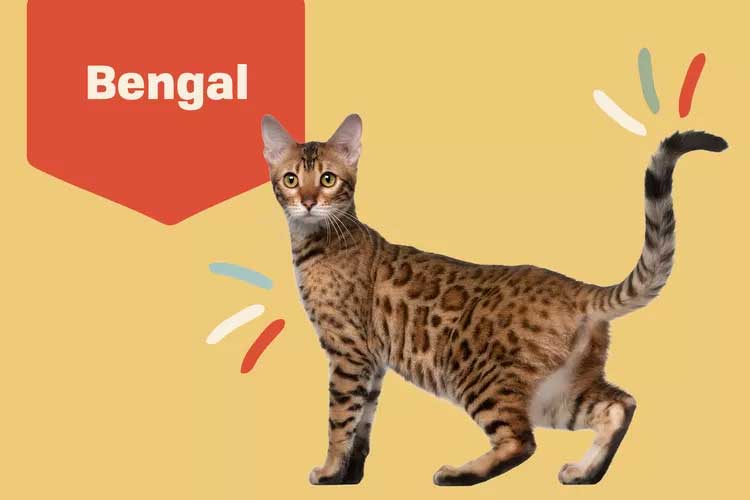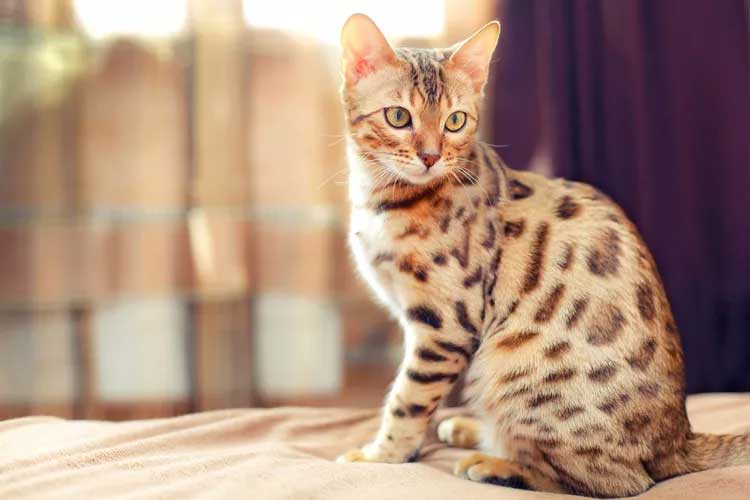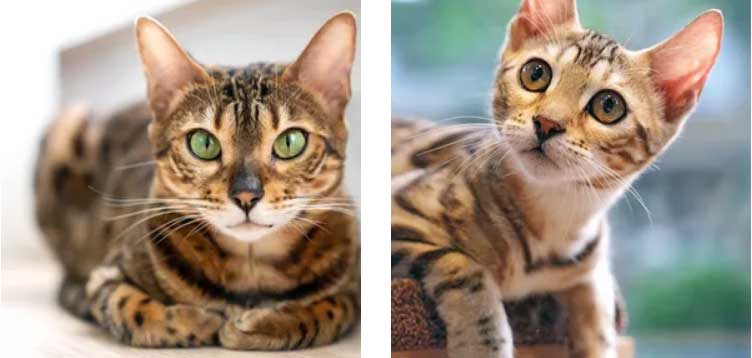Bengal cats are an intelligent and active breed prized for their boldly patterned coats. Descended from domestic cats and wild Asian leopard cats, they make affectionate and gentle pets.

Bengal Overview
| OFFICIAL NAME | Bengal |
| COMMON NAME | Bengal |
| PET HEIGHT | 8 to 10 inches |
| PET WEIGHT | 8 to 15 pounds |
| LIFESPAN | 9 to 15 years |
| GOOD WITH | cats, children, dogs, families, seniors |
| TEMPERAMENT | affectionate, bold, sociable |
| INTELLIGENCE | high |
| SHEDDING AMOUNT | normal |
| PLAYFULNESS | high |
| ENERGY LEVEL | active |
| VOCAL LEVEL | frequent |
| COAT LENGTH | short |
| COLORS | chocolate / brown / sable, lavender / silver |
| OTHER TRAITS | easy to groom, easy to train, friendly toward humans, friendly toward other pets, friendly toward strangers, high prey drive, strong loyalty tendencies |
The first time you see a Bengal cat roaming through your house, you might think a jungle cat has broken in. That's because this spectacular breed sports a spotted or marbled coat that looks a lot like a wild leopard or ocelot. But the Bengal is anything but wild, and has a loving, affectionate personality. While Bengals were developed by breeding domestic felines to an Asian leopard cat, their wild natures have long been abandoned.
Bengal cats were first accepted as a breed in 1983, and since then this handsome cat has skyrocketed in popularity. Like some other hybrid breeds, such as the Savannah cat, Bengal cats are classified by how many generations they are removed from their original wild parent. The kitten of the Asian leopard is called an F1. And every following generation gets a numerical designation such as F2, F3, F4, etc. To be considered a truly domestic cat, a Bengal must be at least an F4.
Before you buy a Bengal cat or kitten, be sure to check with your state and local governments; they are banned in some locations, including Hawaii and New York City. Bengals may also have restrictions if they belong to an F1–F3 generation.
Appearance
Bengal cats are a lithe and agile breed and generally weigh between 8–15 pounds. They're prized for their dense, short coats that are boldly patterned in different shades of brown, silver, and snow. Their fur is super soft to the touch, feeling a bit like bunny hair. The most common eye colors found in Bengal cats are brown, yellow, orange, and green.
A Bengal cat's coat is what sets him apart from all other felines. In fact, Bengals are the only breed that can have rosette markings that directly reflect their wild Asian leopard ancestry. Spotted or marbled coats are also popular and just as gorgeous. Because their fur is so short, they only require a weekly brushing to remove loose hair and dead skin cells.
Although Bengal cats weigh about the same as a typical house cat, they're generally larger in size because of their long, muscular bodies. And their lengthy legs make them excellent jumpers, so don't be surprised if you find your Bengal staring down at you from shelves and countertops.
Temperament
Despite how wild a Bengal looks on the outside, he's soft and sweet on the inside. These affectionate cats are gregarious, although they might christen a particular family member as their favorite. Bengals do great with children, other cats, and with family dogs. The key, however, is early socialization and exposure to household members at a young age. If you try to introduce a new pet to older Bengals already set in their ways, you might have a challenge on your hands.Because Bengals are an intelligent and curious breed, they need constant stimulation to keep their big brains engaged. They love playing with toys and are also known to love water and enjoy a shallow tub. Bengals can be taught tricks and even how to walk on a leash for outdoor adventures.

Bengal cats are also known to be a bit chatty with their owners. They won't meow excessively, but they're pros at telling you exactly what they need, especially if it's "my food bowl is almost empty," or "I want to play." A Bengal also won't sit idly by after you come home from a long day at work. You can expect a royal greeting, complete with a serenade.
Marilyn Krieger, CCBC, San Francisco-based cat behaviorist, says Bengals are known for this loud vocalization. She has both a Bengal and a Savannah cat. "But, of course, not all Bengals are loud," she says. Her own cat's vocalizations are melodious, and she and her Bengal, Molly, often sing songs together. "She makes different types of noises" during their duet, Krieger says.
Living Needs
A Bengal cat is happiest when he's near you. He doesn't care where he lives, whether it be a big house or small apartment, as long as you and your family are nearby. But no matter the size of your space, a Bengal needs to have lots of things to do—and climb.Owners should have at least one cat tree for this big kitty, along with plenty of toys to keep him entertained while you're away. And if you spend long hours away from home, having a second cat is a good idea to help keep your pet amused and busy.
Bengal cats also have a high prey drive and enjoy watching birds, squirrels, and other animals from safely inside your home. Because of his love of chattering at the window, it's a great idea to install a carpeted perch (or two) to give him a comfortable viewing spot.

Just try not to leave breakable items on a shelf or mantel that your Bengal can reach. Remember: This breed is super agile, so it's inevitable your cat will eventually explore every high-up spot he can reach. So, if you're proud of your Faberge egg collection, secure them someplace where your cat can't knock them over. Installing cat shelves in your home could help keep him away from your breakables, too!
And although they're not considered couch potatoes, Bengals will curl up on your lap for a good snooze after a busy day of chasing toy mice.
Care
Mental stimulation is the key to a happy Bengal cat. Start young by introducing your kitten to other people, children, animals, the car, and even a leash and harness for outdoor jaunts. Because they're so intelligent, Bengals benefit from a wide range of experiences to keep them engaged, so work with them early and often. It also helps to provide plenty of cat toys and rotate them out every few weeks so your cat doesn't get bored.
"Bengals are highly intelligent cats and need activities," Krieger says. She also recommends clicker training your cat. "It keeps them mentally and physically stimulated. They have to think!"
Caring for a Bengal's coat is easy: All you need to do is brush them once a week to keep their coat in top condition. And because they love water so much, an occasional bath might be something they look forward to. Regular tooth and nail care is important, as it is for any cat breed.
Health
The typical Bengal cat lifespan is 9–15 years, and they're a relatively healthy breed. However, as with all cats, they do have a few health issues you need to keep in mind before you purchase a new pet. Most serious breeders are careful to breed animals without genetic health problems, but three of the most common maladies among Bengals are:Heart disease: Heart disease in Bengal cats is called hypertrophic cardiomyopathy, which can cause the heart muscle to thicken, particularly in older animals. This can result in blood clots or congestive heart failure and a shorter lifespan.
Eye disease: Bengals can also get an eye condition called progressive retinal atrophy, which can cause deterioration of the retina and eventual blindness.
Anesthetic allergies: Bengals can be extremely sensitive to anesthetics and should be watched carefully during any surgeries—including neutering and spaying. An allergic reaction to anesthetics can result in cardiac arrest.
History
Although crosses between Asian leopard cats and domestic cats occurred as early as the 1800s, the breed didn't really come into its own until the mid-20th century. Breeder and conservationist Jean Mill first crossed a domestic cat with an Asian leopard cat in 1963, according to the Cat Fanciers' Association. By 1996, Bengals were registered by the CFA. The accepted animals come from the F6 generation or higher.Of course, when you consider their warm, intelligent personalities and eye-popping coat colors and patterns, it's no surprise that they have quickly become one of the most popular breeds in the world, outpacing cats that have been around for generations.
Fun Facts
Do you remember the rock group Jethro Tull? The group’s famous flautist, Ian Anderson, was an early fan of the Bengal cat and has promoted the breed for years.Other prominent Bengal owners have included Jerry Seinfield, Kristen Stewart, Barbara Mandell, Kourtney Kardashian, and Bruce Springsteen.
Thor, a large spectacularly marked Bengal cat from Belgium, is so popular he has his own Facebook and Instagram accounts with hundreds of thousands of adoring fans.
Contrary to myth, Bengal cats are not immune to feline leukemia. They are just as susceptible as other breeds of cat and should be vaccinated against the disease if they spend time outdoors or are around other cats.
The Bengal’s Asian leopard ancestor has the scientific name Prionailurus bengalensis. The Bengal breed gets its name from the species name bengalensis, not from the Bengal tiger as some people might think.